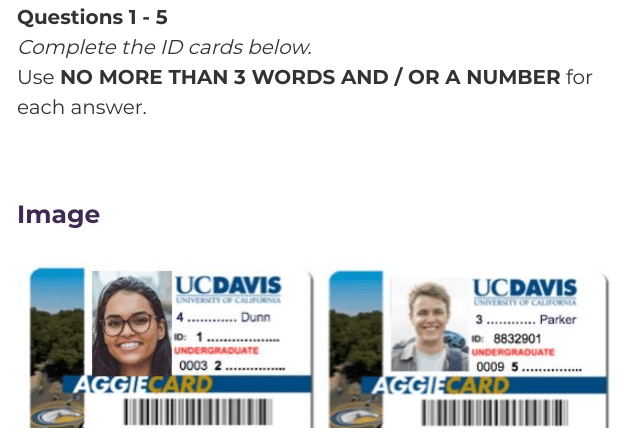In this article, we’ll be focusing on Part 1 of the IELTS Listening practice test!
You’re going to see what you can expect to find in Part 1, see some sample questions and transcripts, see how Part 1 is graded and what’s the highest score you can get, as well as look at the difficulties some candidates have with Part 1.
Find the best preparation online for the IELTS test. So, let’s have a look at Part 1!
What Could You Expect To Find in The Listening Part 1?
Part 1 of the IELTS Listening Section is a recording of a 2-3 minutes telephone dialogue. It is ‘transactional’, meaning that one person in the dialogue wants something. They might want to join a club, or to inquire about a product or service, or it might be something connected to their university studies.
On your test paper, you see some notes from one side of the recording of the conversation, but they’re incomplete. As you listen, you need to complete the notes as answers for the section.

IELTS Listening Part 1 Sample Questions And Transcripts For Practicing
Working with sample questions and transcripts is one of the best ways to improve your score. Let’s have a look at some examples from our learning platform. Read the questions carefully:
Sample Question 1
Part 1 is always a conversation between two speakers and the language is quite straightforward. Have a look at the example extract below:
Sarah and Grace, two longtime friends, are eating lunch at a casual restaurant planning a trip.
Grace: “Let’s eat here, Sarah. I just want to sit down somewhere so we can talk about some ideas for our trip!!!!”
Sarah: “Oh yeah yeah, like what? Come on, let’s sit in this booth, the light is better.
Everything looks so good on the menu. What do you feel like? I think I am going to have the vegetarian wrap.
Grace: I don’t know… The chicken sandwich with pesto looks good.
Here is an example question:
What is Sarah most likely going to order?
- A chicken sandwich with pesto.
- A vegetarian wrap.
- An everything burger.
Remember, you don’t need to understand exactly what is said, but you need to be able to answer the question! As you can see, the question isn’t too difficult.
Sample Question 2
Often the dialogue from Part 1 will be between a student and someone who works for the university or college. Have a look at the example below.
A: You are through to the student finances department. This is Geraldine speaking. How may I help you?
B: Hi Geraldine. I want to arrange my fee payments for my first year at university. I am starting this September so I need to pay as soon as possible.
A: No problem, you are three days off missing the deadline, so if you can pay today you won’t incur the late payment fee of 200 Euro. So…..you have been offered a course here at Montrose University? Did you get a letter?
B: Yes, I got the letter back in June, I have it here in front of me.
A: Great, so please call out the student number on that letter.
B: Where is it located, I can’t seem to find it?
A: It will be printed on the top right corner right under the logo and date of offer.
Below is an example question:
Where did Geraldine ask Marc to look for his student number?
A.
B.
C.

This time the question is slightly different as you need to refer to the diagram. Very often in Part 1 they’ll ask you about the position of something. Make sure you’re comfortable with left, right, top and bottom before you take the test!
Sample Question 3
You always need to pay attention to the instructions for the questions. For example, imagine you see:
Give a short response to the questions below.
Use NO MORE THAN 2 WORDS for each answer.
This means you can use a maximum of two words, and no numbers. Therefore, it is very important if you write “3” and not “three” because it will be marked as incorrect. In the following extract, you’ll see a conversation between a Hall Director and a student:
Student : Thanks, wow, I love your office! The decorations are so trendy!
Hall Director : Thanks, my wife is an interior designer, so I’m not going to lie, she did help me choose most of the things in here.
The related question is as follows:
What is the hall director’s wife’s profession?
Keeping in mind the instructions, if you write “an interior designer”, it’s incorrect, as you can only write your answers in one or two words.
Sample Question 4
In this question paper, read instructions carefully because they are slightly more complicated:

You need to complete the ID cards according to the information that you hear using a maximum of three words with a number, or simply a number. IELTS questions can often be confusing – this is why practice is so important!
Student B: I think you might seem a little confused, there is no O’Flaherty cafeteria over here in The University of Davis, however there’s a McKibben’s cafeteria just down the street, around a 10 minute walk. May I have your student number and the program you are in please.
Student A: My student number is 1382627 and I am currently in Economics section 0003 BDF-383- ECON. May I ask why?
Student B: Thanks I’ll just pop it into the iPad here….my name is Gerald…..I see your name is James Dunn
As you can see, they give the information only once, so you need to know the alphabet and numbers well!
On GlobalExam’s platform you can find many more examples of these types of questions – you can listen to the audio, replay the audio, read the transcriptions and get explanations of the correct answers!
To prepare well, you also need to know how the scoring works and how difficult Part 1 of the IELTS Listening test can be.
IELTS Listening Part 1: What’s the Maximum Score You Could Get?
You can score a maximum of ten marks in Section 1. There are 10 questions, worth one mark for each answer. To be awarded a mark, you must:
- spell all word(s) correctly
- use appropriate punctuation (like capital letters for names)
- show that you understand some ‘conventions’ for how we write things in English – for example, when writing the floors of a building, we write “3rd/third floor”, not “3/three floor”.
You also need to take note of the word limit. Many IELTS tests such as the Writing tasks have an instruction like “Write NO MORE THAN THREE WORDS AND/OR A NUMBER” at the top of the page.
How Difficult Could the IELTS Listening Part 1 Actually Be?
Stronger candidates usually find this the easiest section of the test, but there can be some problems. Weaker candidates often struggle to write down all the information quickly and accurately, because the answers are not equally spaced apart – there can be a long gap in the recording between one answer and the next, then two or three answers close together. Do not forget that you must also work on the other parts of the listening test, such as the IELTS Listening Part 2, IELTS Listening Part 3 and last but not least, IELTS Listening Part 4.
What kind of information do I need to write?
The information could vary depending on the subject, but there will often be addresses and locations requested. If the conversation is about a product, for example, you might need to write down the location of the shop where the product is sold. For this, it’s useful to review some prepositions (e.g. in the town centre, behind the cinema) and to make sure you know all the different types of street names there are in English – Road, Close, Avenue, Lane and so on.
“How do you spell that?”
One thing you will always need to do in Listening Section 1 is write the name of a place, a person or a product, which is spelled on the recording.
In the example, Maria Garcia is checking into student accommodation. During the phone call, you will hear this exchange:
Accommodation officer: “Maria… can you spell your surname please …
Maria: “sure it is….G-A-R-C-I-A”
This type of question can cause problems for some candidates, because the English alphabet has some ‘difficult letters’. Some pairs sound similar – a lot of people find the sounds of G and J hard to distinguish, while others confuse I and E or I and A. Candidates may also not be used to hearing the names of some letters, like H and Y.
Study And Practice For The IELTS Test Online With GlobalExam
To maximise your score, practice all sections a lot before you take the IELTS test. After each practice test, make a note of any mistakes you made in questions where people spell words. First, try to identify letters that are difficult for you. Then, continue practicing with the goal of hearing those ‘difficult letters’ more clearly.
On GlobalExam, you can study for IELTS thanks to many exercises, answer sheets and mock exams. This way you will get used to the question types, and become more confident. Each exercise has a correction, so you can follow your progress over time. Register now for free and try our platform!
Even if you’re not training for IELTS, GlobalExam can still help you! Our e-learning platform is available in 5 different languages (Spanish, Mandarin, French, German and English). We also provide training for 27 different language tests, including TOEFL and TOEIC. Our pedagogical experts regularly update the questions on the platform so that you know your training is really what you need.
Let GlobalExam help you reach your language learning goals!



